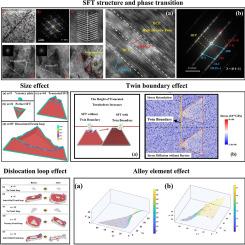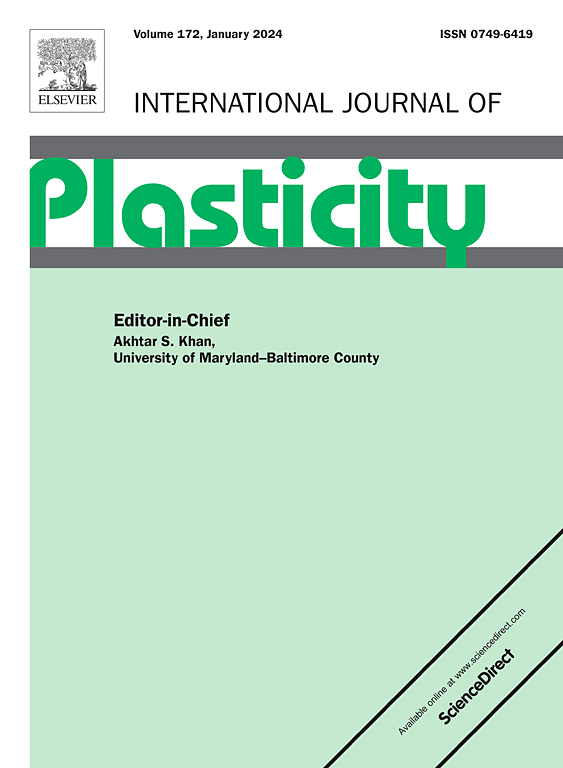了解催化裂化不锈钢中堆积断层四面体的形成:透射电子显微镜、分子动力学和机器学习的融合
IF 9.4
1区 材料科学
Q1 ENGINEERING, MECHANICAL
引用次数: 0
摘要
堆叠畸变四面体(SFT)的形成显示出明显的尺寸效应,从空缺等边三角形板到完美 SFT,最终到截断 SFT,这在许多辐照面心立方金属中都得到了证明。然而,关于 F321 不锈钢中存在独特的 SFT 结构的报道尚未见诸报端。本研究利用透射电子显微镜(TEM)、分子动力学(MD)模拟和机器学习,探索了辐照 F321 不锈钢中 SFT 的形成机制。研究发现,辐照 F321 钢中广泛存在 SFT、Frank Loops 和 Lomer-Cottrell locks。利用 MD 模拟确定了截短和完美 SFT 的临界尺寸;结果与理论预测一致。此外,通过 TEM 观察到的孪生边界可归因于边界附近拉伸应力的升高,这有利于完美 SFT 的形成。此外,间隙弗兰克环也促进了完美 SFT 的形成。本研究还采用 MD 和机器学习相结合的方法,探讨了镍和铬浓度变化对从空位板过渡到完美 SFT 的临界尺寸 n1 和从完美 SFT 过渡到截断 SFT 的临界尺寸 n2 的影响。随着镍浓度的增加和铬浓度的降低,n1 和 n2 增加;相反,当镍浓度降低和铬浓度增加时,临界尺寸减小。这些见解揭示了不同条件下 SFT 形成的系统机制,为理解 F321 不锈钢中的纳米缺陷提供了新的视角。本文章由计算机程序翻译,如有差异,请以英文原文为准。

Understanding Stacking Fault Tetrahedron Formation in FCC Stainless Steel: A Fusion of Transmission Electron Microscopy, Molecular Dynamics, and Machine Learning
The stacking fault tetrahedron (SFT) formation displays a pronounced size effect, progressing from vacancy equilateral triangular plate to perfect SFT, and eventually to truncated SFT, as demonstrated in numerous irradiated face-centered cubic metals. However, the presence of distinct SFT structures in F321 stainless steel has not been reported. This study explored the SFT formation mechanism in irradiated F321 stainless steel using transmission electron microscopy (TEM), molecular dynamics (MD) simulations, and machine learning. SFTs, Frank loops, and Lomer-Cottrell locks were found to be widely generated in the irradiated F321 steel. The critical size for truncated and perfect SFTs was determined using MD simulations; the results were consistent with the theoretical predictions. Additionally, the twin boundaries observed through TEM, which were attributed to the elevated tensile stress near the boundaries, facilitated the formation of perfect SFTs. Moreover, interstitial Frank loops also facilitated the formation of perfect SFTs. This study also explored the influence of variations in Ni and Cr concentrations on the critical size n1 for the transition from vacancy plates to perfect SFTs and n2 for the transition from perfect SFTs to truncated SFTs, using a combination of MD and machine learning methods. As the Ni concentration increased and the Cr concentration decreased, n1 and n2 increased; conversely, the critical sizes decreased when the Ni concentration decreased and the Cr concentration increased. These insights reveal the systematic mechanism of SFT formation under varied conditions, offering new perspectives for understanding the nano-defects in F321 stainless steel.
求助全文
通过发布文献求助,成功后即可免费获取论文全文。
去求助
来源期刊

International Journal of Plasticity
工程技术-材料科学:综合
CiteScore
15.30
自引率
26.50%
发文量
256
审稿时长
46 days
期刊介绍:
International Journal of Plasticity aims to present original research encompassing all facets of plastic deformation, damage, and fracture behavior in both isotropic and anisotropic solids. This includes exploring the thermodynamics of plasticity and fracture, continuum theory, and macroscopic as well as microscopic phenomena.
Topics of interest span the plastic behavior of single crystals and polycrystalline metals, ceramics, rocks, soils, composites, nanocrystalline and microelectronics materials, shape memory alloys, ferroelectric ceramics, thin films, and polymers. Additionally, the journal covers plasticity aspects of failure and fracture mechanics. Contributions involving significant experimental, numerical, or theoretical advancements that enhance the understanding of the plastic behavior of solids are particularly valued. Papers addressing the modeling of finite nonlinear elastic deformation, bearing similarities to the modeling of plastic deformation, are also welcomed.
 求助内容:
求助内容: 应助结果提醒方式:
应助结果提醒方式:


